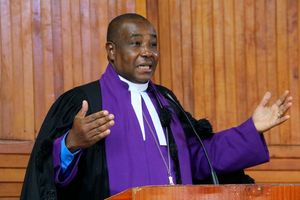Premium
School unrest, official violence and the state’s hatred for young people

A fire engines battles raging flames after a dormitory at Karima Boys High School in Nyeri County caught fire on November 27, 2021.
What you need to know:
we were taught that the school is a community, comprising a dynamic interaction between the interests of diverse stakeholders.
The contemporary school, besides being a community, is a formidable economic unit.
It is time for us to come to grips with the fact that our state and society have a huge problem with the youth. For appropriate guidance, consider two scenarios in the light of recent school disturbances.
According to Dr Fred Matiang’i, our education system is shipshape and our schools perfectly fit for purpose.
The man in charge of the deployment of official violence in the republic recommends the hearty walloping of learners as a particularly inspired solution to all the problems in our schools.
He has, therefore, promulgated this prescription for immediate execution by his Education counterpart, Prof George Magoha.
Prof Magoha and Dr Matiang’i fall among our better-educated public officers whose academic credentials confer authority and inspire public confidence. In other words, they ought to know better, and speak more sensibly on a topic so elementary.
The other remarkable scenario relates to an aspect of discourse about the ferment in our boarding secondary schools: the absolute confidence and certainty with which learners have been singled out as the culprits.
Debate is therefore restricted to possible solutions given that learners are the problem.
There is a particular form of cognitive failure that leads to this sort of frightful intervention.
It fails to take into account the essential character of a school, which is disturbing, since we all attended school, and many of us, the standard Kenyan variety.
Perpetually under siege
There, we were taught that the school is a community, comprising a dynamic interaction between the interests of diverse stakeholders. In Social Education and Ethics, we were encouraged to enumerate these stakeholders as learners, sponsors, government (political and administrative leadership), parents, teachers, non-teaching staff and suppliers.
These stakeholders are presumed to be motivated by a common interest, which is the basis of harmonious coordination and cooperative effort towards the success of the school.
The contemporary school, besides being a community, is a formidable economic unit. With the expansion of enrolment to accommodate growing populations, a modest rural school easily serves a few hundred learners, each of whom is responsible for up to Sh20,000 in fees annually, besides government capitation.
A typical crowded, in-demand urban school operates on a significantly more intense scale. Quite a number have over a thousand learners who pay considerably more, and therefore run budgets beyond Sh50 million annually.
Schools, therefore, are targets of myriad permutations of competitive intrigues among actors seeking access to these resources.
Each stakeholder category is a node, anchoring contentious manoeuvres to influence school management.
The school principal, who is the chief executive officer and secretary of the board of management, is a notorious focal point of blistering stakeholder rivalries. Principals are perpetually under siege.
It stands to reason then, that school unrest is highly strategic to many disaffected characters for various reasons and, obviously, the nastier, the better.
Strikes used to be the easiest means of dislodging a principal, because riotous disorder, destructive rampage and ominous plumes of smoke have a way of dramatically extinguishing a principal’s credibility.
Successful arson attack
Management succession, supplier disputes, local politics and even inter-denominational animus over sponsorship are some sources of infernal motives for unrest.
Clearly, the learner is at best a peripheral actor in this labyrinth of conspiracy. Her (re)actions are incidental, mere culminations of underlying fundamental problems.
In any event, the supply chain involved in a successful arson attack is certainly indicative of complicity by actors outside the school dorm.
The school is not just any organisation; it is a lucrative parastatal of the feistiest order. Something about solvent parastatals awakens the gangster in many a Kenyan.
Consider the Kenya Medical Supplies Agency, Kenya Pipeline Company, or the Youth Fund. Why should schools be any different?
To protect schools and their principals from the terror of perpetual siege, it is time to entrench sound corporate governance techniques in school management, and accordingly update the Ministry of Education and Teachers Service Commission. The tyrannical proclivities of retrogressive bureaucrats have no place in sound education management.
Dr Matiang’i’s draconian proposal disabuses us of all illusions regarding the government’s seriousness in upgrading its capacity to run a modern education system.
The dreadful proposal that schools be run like the animal pens in a particularly mediocre farm ignores the diversity of interests comprising a school community, and reduces learners to inert inmates without any agency whatsoever.
The suggested linear connection between inputs (violence) and outputs (educational outcomes) relegates human subjects into the realm of mechanical objects. But it is the recommendation that institutional problems can be solved through the brutal infliction of violent injury that provokes profound misgiving about the sanity of our government, and its perennial disaffection with young people.
Since mau mau, the Kenyan state, of which the Jubilee administration is a constitutional successor, has harboured a lively desire to exterminate young people through violence.
The writer is an advocate of the High Court and a former State House speech writer.





